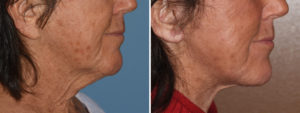
A Facelift Changes The Whole Face While the term facelift implies that it is a total face changing operation, the reality is that it only changes the lower portion of it. The history of the facelift is that as far back as one hundred years ago it was a small operation to just remove a few wrinkles on the side of the face in front of the ears. That is where its formal name, rhytidectomy or the excision of wrinkles, has it origin. While the operation today is a far more aggressive procedure than the removal of a few wrinkles, its effects are limited to the neck and jowl line or the lower third of the face. For changes in other parts of the face, a facelift must be combined with other operations such as eyelid lifts which it frequently is.
Facelifts Will Change How One Looks While the objective of a facelift is to make one look less aged and have a rejuvenated appearance, it’s objective is not to change one’s face to a new or unrecognizeable one. It’s intent is to take one back a decade or so and give one a younger look. By getting rid of jowls and loose neck skin, one is spinning the clock back so to speak. Since a facelift only affects the lower face, it has no capability to change the upper parts of the face.
Facelifts Tighten The Facial Muscles The main tissue tightening effects of a facelift are of loose skin and the tissue layer over the facial muscles known as the submusculoaponeurotic system. (SMAS) The tightening of the SMAS is often confused with that of the underlying muscles. The very large masseter (chewing) muscle on the side of the face can’t be lifted and tightened as they are attached to the jawbone and have the branches of the facial nerve sitting on top of them. In fact, the only muscle tightened in a facelift is in the neck and is known as the platysma muscle. Its separation with aging is the cause of vertical neck bands and sewing it back together both eliminates the bands and sharpens the neck angle.
Non-Surgical or Injectable Facelifts Work With the introduction of Botox, injectable fillers and laser treatments, numerous ‘facelifting’ procedures have been devised using various combinations of them. Called by such names as Liquid facelifts, Vampire Lifts, and Non-surgical facelifts to name a few, their names suggest that they have comparative effects as a surgical facelift. While such procedures have a role to play in facial rejuvenation, they are no match for what actual facial tissue lifting and tightening can do. No amount of plumping or skin resurfacing can really lift up a significantly sagging face. And often, unfortunately, they can be a poor use of one’s financial resources in the hope of achieving a result that never was possible. Patient selection and education is crucial in the use of these non-surgical facelifts.
Facelift Surgery Has A Long Recovery While comprehensive facelifting that includes many other procedures, such as eyelid lifts, browlifts and laser resurfacing, can involve up to a month of recovery (to the point of looking acceptable) due to the amount of tissue trauma), this is not true for many facelifts. When it is done as a stand alone procedure, one can look very acceptable in as little as ten to fourteen days after surgery. With many of the new scaled down or mini-facelifts, such as the Lifestyle Lift and Quicklift, the recovery can even be shorter.
Dr. Barry Eppley
Indianapolis, Indiana


